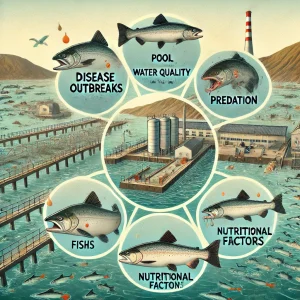Rainbow Trout
Rainbow Trout Hatching and Information
Explore UK Fish Production Insights
Learn How to Reduce Hatchery Losses
Access Expert Strategies for Successful Aquaculture
Production Overview
Rainbow trout is a key species in global aquaculture, with production reaching 848,000 tonnes in 2020. The UK produced 14,000 tonnes of rainbow trout that year.


Survival Rates and Losses
Survival Rates: Under optimal conditions, rainbow trout (Oncorhynchus mykiss) egg survival rates can reach up to 95%. However, various factors can influence these rates, leading to variability in survival outcomes.
Losses: Significant losses, sometimes exceeding 30%, have been reported due to factors such as bacterial and fungal infections, suboptimal water quality parameters, and handling stress during the egg stage. Fungal infections, particularly those caused by Saprolegnia species, are a major concern in hatcheries, leading to substantial egg mortality if not properly managed.
Economic Impact: Elevated mortality rates result in decreased fry production, increased operational costs, and potential revenue losses, thereby disrupting production cycles and affecting overall profitability. To mitigate these risks, the implementation of advanced water quality monitoring systems and the adoption of best management practices are recommended to enhance egg survival rates and ensure economic sustainability in trout farming operations.
Overall Challenges
Rainbow trout face several challenges that contribute to production losses:
- Disease Outbreaks: Rainbow trout are susceptible to bacterial and viral infections.
- Poor Water Quality: Issues with oxygen levels and temperature fluctuations are major stressors.
- Predation: Trout are highly vulnerable to predators, especially in hatchery life stages.
- Genetic Factors: Genetic predispositions can affect survival and growth rates.
- Nutritional Deficiencies: Inadequate nutrition can impair development and weaken immune defences.


Challenges in Early Life Stages
In the egg stage, rainbow trout face similar challenges to salmon:
- Fungal Infections: A common problem, often linked to poor water quality.
- Oxygen Deprivation: Critical to the viability of the eggs.
- Temperature Fluctuations: This can lead to significant egg mortality.
As rainbow trout progress to the alevin stage:
- Yolk Sac Malformation: This issue can impede feeding and proper growth.
In the fry stage:
- Disease Susceptibility: Increased vulnerability to diseases is a major concern.
- Cannibalism: Cannibalism among fry is a significant issue.
- Nutritional Management: Ensuring adequate and precise nutrition is essential for healthy development.
Mitigation Strategies
Rainbow trout farmers and hatcheries use a variety of strategies to overcome these challenges:
- Disease Management: Biosecurity, vaccinations, and selective breeding can help prevent disease outbreaks.
- Water Quality Control: Advanced systems such as RAS ensure stable and optimal water conditions.
- Nutrition: Stage-specific feeds and controlled feeding schedules help improve health and growth.
- Genetic Improvement: Selective breeding programs are in place to enhance disease resistance and growth performance.
- Environmental Control: Managing temperature, oxygen, and stocking density is critical for the welfare of trout.
- Predator Control: Measures such as netting, predator-proof enclosures, and predator removal can help reduce predation.
- Sustainable practices: Adopting sustainable aquaculture practices using AI, IoT, as well as reducing environmental impact and improving animal welfare, can help ensure the long-term viability of the industry.

How AIquaboost Can Help
By integrating AIquaboost into your hatchery operations, you gain access to:
- Real-Time Monitoring: Continuous tracking of key water parameters.
- Predictive Analytics: Early warnings for potential issues like temperature spikes or pathogen outbreaks.
- Resource Optimization: Smart management of aeration, water flow, and heating systems to lower costs.
- Actionable Insights: Data-driven recommendations to improve egg survival rates and overall hatchery performance.
Optimizing Success in Rainbow Trout Hatcheries
Rainbow trout hatcheries encounter distinct challenges, but with the right strategies and advanced tools, these challenges can be effectively managed. AIquaboost provides hatchery managers with the ability to optimize environmental conditions, reduce mortality rates, and enhance survival rates, ensuring the production of robust and healthy fry.
Contact us today to discover how AIquaboost can revolutionize your rainbow trout hatchery operations and improve egg management for better yields.